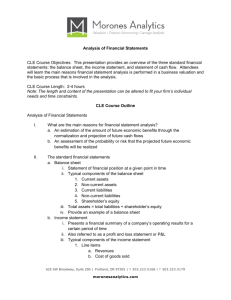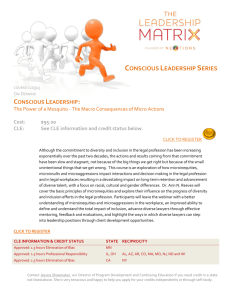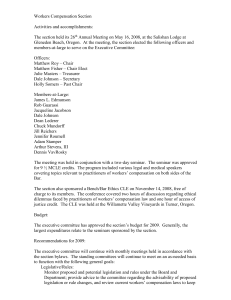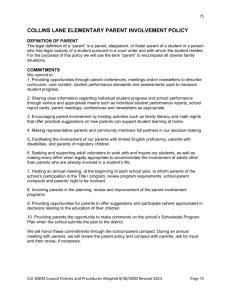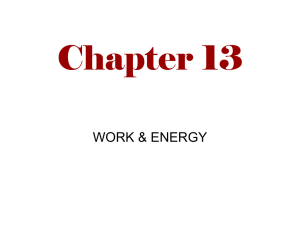Cloud”: How to Navigate Before You are
advertisement
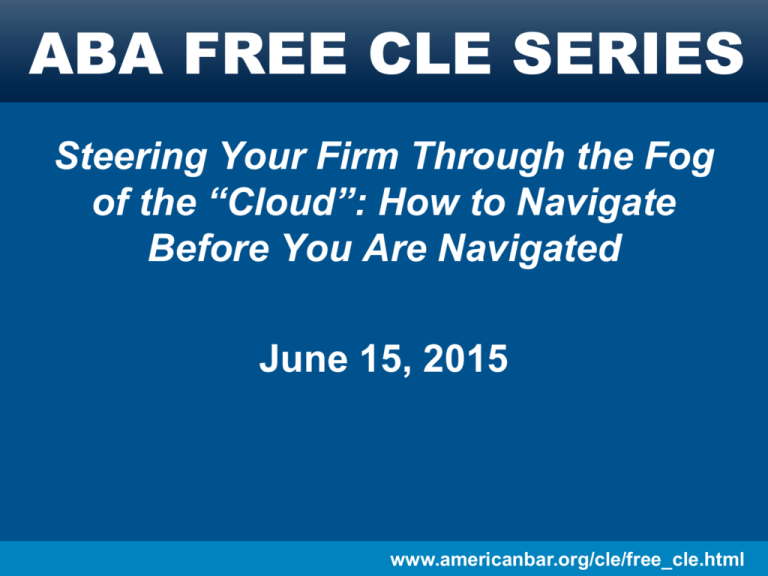
ABA FREE CLE SERIES Steering Your Firm Through the Fog of the “Cloud”: How to Navigate Before You Are Navigated June 15, 2015 www.americanbar.org/cle/free_cle.html Clinton Mikel is a Partner with The Health Law Partners, P.C. He is a graduate of Cornell University and the University of Michigan Law School. Mr. Mikel is the Chair of the American Bar Association, Health Law Section’s, eHealth, Privacy & Security Interest Group. Mr. Mikel practices in almost all areas of healthcare law, but devotes a substantial portion of his practice to compliance with federal and state health care regulations and transactional matters. Mr. Mikel has expertise in HIPAA and state privacy laws, federal and state information breaches (strategic investigations and disclosures), state and federal telehealth/telemedicine issues, federal and state selfreferral laws, including Stark, federal and state antikickback laws, and information technology issues. cmikel@thehlp.com Phone: (248) 996-8510 www.thehlp.com https://www.linkedin.com/in/clintonmikel www.americanbar.org/cle/free_cle.html The “Cloud” What is the Cloud? Where is the Cloud? Are we in the Cloud now? www.americanbar.org/cle/free_cle.html What is not the “Cloud”? • The Cloud is not your hard drive (i.e., local storage). • The Cloud is not your dedicated network attached storage (NAS) hardware or server in residence. • For it to be considered “Cloud Computing” it must involve accessing data or programs over the Internet or synchronizing data with info over the Internet. www.americanbar.org/cle/free_cle.html So, what is the “Cloud”? • The National Institute of Standards and Technology (NIST) defined Cloud Computing as: “a model for enabling ubiquitous, convenient, on-demand network access to a shared pool of configurable computing resources (e.g., networks, servers, storage, applications and services) that can be rapidly provisioned and released with minimal management effort or service provider interaction.” • See, NIST Special Publication 800-145 (9/2011). www.americanbar.org/cle/free_cle.html What is the “Cloud”? • Cloud Computing: – Five essential characteristics: 1. On-demand self-service; 2. Broad network access; 3. Resource pooling; 4. Rapid elasticity or expansion; and 5. Measured service. – Three service models: (1) software; (2) platform; and (3) infrastructure. – Four deployment models: (1) private; (2) community; (3) public; and (4) hybrid. www.americanbar.org/cle/free_cle.html 3 Cloud Computing Service Models 1. Infrastructure as a Service (IaaS). The consumer does not manage or control the underlying cloud infrastructure but has control over operating systems, storage, and deployed applications; and possibly limited control of select networking components (e.g., host firewalls). – Allows custom design/”buy” – Vendor may run software-as-a-service with IaaS subcontract to data center www.americanbar.org/cle/free_cle.html 3 Cloud Computing Service Models 2. Platform as a Service (PaaS). The consumer does not manage or control the underlying cloud infrastructure including network, servers, operating systems, or storage, but has control over the deployed applications and possibly configuration settings for the application-hosting environment. – Allows custom design/”buy” – Vendor may run software-as-a-service with PaaS subcontract to data center www.americanbar.org/cle/free_cle.html 3 Cloud Computing Service Models 3. Software as a Service (SaaS). Applications are accessible from various client devices through either a thin client interface, such as a web browser (e.g., web-based email), or a program interface. The consumer does not manage or control the underlying cloud infrastructure including network, servers, operating systems, storage, or even individual application capabilities, with the possible exception of limited user-specific application configuration settings. – Commodity www.americanbar.org/cle/free_cle.html Cloud Computing • Remember, with cloud computing: You do not have physical possession of cloud data or the hardware on which it’s stored; You (and sometimes even the cloud vendor) often does not know where the information resides at any given moment; and Your rights are defined entirely by contract. www.americanbar.org/cle/free_cle.html What services are in the “Cloud” for attorneys? • Storage and backup • Document and case management • Time/Billing • File sharing • Remote access • Blogging • Social media • Data analytics • Collaboration (e.g., web conferencing) www.americanbar.org/cle/free_cle.html Dennis Garcia Dennis Garcia is an Assistant General Counsel for Microsoft based in Chicago. He leads the legal support function to Microsoft’s U.S. Central Region Enterprise & Partner Group. In this role Dennis shapes and negotiates a wide range of agreements with Microsoft’s largest customers and partners. He also provides general corporate legal advice and counsel. Prior to joining Microsoft, Dennis served as in-house counsel for Accenture and IBM. Dennis received his B.A. in Political Science from Binghamton University and his J.D. from Columbia Law School. He is admitted to practice in New York, Connecticut and Illinois (House Counsel). Dennis also has Certified Information Privacy Professional (CIPP)/US and Certified Information Privacy Technologist (CIPT) credentials from the International Association of Privacy Professionals (IAPP). Dennis can be reached at dennisga@microsoft.com. You can follow Dennis on Twitter at https://twitter.com/denniscgarcia. www.americanbar.org/cle/free_cle.html What is the “Cloud”? The Cloud is Not New Different Definitions of the Cloud • NIST Definition • Simple Definition: “a fancy way of saying stuff’s not on your computer” • On-Premise Versus OffPremise Benefits of the Cloud Challenges of the Cloud www.americanbar.org/cle/free_cle.html Common Cloud “Lingo” Server Multi-Tenant Dedicated Data Center Data at Rest Data in Transit SLA SaaS IaaS PaaS Public Cloud Private Cloud Hybrid Cloud Community Cloud www.americanbar.org/cle/free_cle.html Michael E. Clark Michael E. Clark practices in the area of litigation with concentrations in securities and financial fraud, as well as white-collar law and healthcare law in administrative, civil and criminal matters. Mr. Clark has been lead counsel in more than 100 jury trials. He has counseled clients, including healthcare providers, insurers and financial institutions, and has conducted internal investigations and advised on compliance and corporate governance matters. Mr. Clark is the Chair for the ABA's Section of Health Law and a former chair of the White-Collar Crime Committee in the ABA Section of Business Law. He co-chairs and serves on the Planning Committee for the National Institute on Internal Investigations and Forum for In-House Counsel and he also is on the Planning Committee for the National False Claims Trial Institute. Phone: +1 713 402 3905 Fax: +1 713 583 9182 Email: meclark@duanemorris.com www.americanbar.org/cle/free_cle.html Legal-Ethical Issues Associated with The Cloud What is addressed in this segment Overlapping regulatory schemes The threat landscape The risks posed to law firms and lawyers by hackers, disloyal employees, and others from not appropriately securing clients’ data and transmitting sensitive information by email. www.americanbar.org/cle/free_cle.html A Patchwork of Domestic Legislative and Administrative Standards The Federal Trade Commission Act The Health Insurance Portability and Accountability Act of 1996 (“HIPAA”), and the Health Information Technology for Economic and Clinical Health Act (“HITECH Act”) The Gramm-Leach-Bliley Act (“GLBA”) www.americanbar.org/cle/free_cle.html A Patchwork of Domestic Legislative and Administrative Standards (cont’d) The Americans with Disabilities Act Children's Online Privacy Protection Act Fair Credit Reporting Act (“FCRA”) and the Fair and Accurate Credit Transactions Act (“FACTA”) www.americanbar.org/cle/free_cle.html A Patchwork of Domestic Legislative and Administrative Standards (cont’d) The Electronic Communications Privacy Act (The Stored Communications Act and Wiretap Act), and the Telephone Consumer Protection Act. The Video Privacy Protection Act The National Institute of Standards and Technology (“NIST”) www.americanbar.org/cle/free_cle.html A Patchwork of Domestic Legislative and Administrative Standards (cont’d) The Cyber Intelligence Sharing and Protection Act, H.R. 624 (113th Cong.) (reintroduced in House in January 2015) (Any company can “use cybersecurity systems … to protect [its] rights and property” … then share that information with third parties, including the government . . . for “cybersecurity purposes”) www.americanbar.org/cle/free_cle.html A Patchwork of Domestic Legislative and Administrative Standards (cont’d) Breach notification HIPAA / HITECH HHS OCR www.americanbar.org/cle/free_cle.html A Patchwork of Domestic Legislative and Administrative Standards (cont’d) What is a reportable “Breach” under HIPAA? Acquisition, access, use, or disclosure of unsecured PHI not permitted by the Privacy Rule unless there is low probability the PHI has been compromised based on a risk assessment. Breach presumed unless demonstrated otherwise. March 1, 2016, reporting deadline for calendar year 2015 small breaches (where < 500 individuals impacted). State Law Considerations. www.americanbar.org/cle/free_cle.html A Patchwork of Domestic Legislative and Administrative Standards (cont’d) FTC Enforcement Section 5(a) of the Federal Trade Commission Act (“FTC Act”), 15 U.S.C. § 45(a), prohibits “unfair or deceptive acts or practices in or affecting commerce” FTC has brought over 30 enforcement actions have since May 1, 2011 and over 50 since 2000 FTC’s Health Breach Notification Rule www.americanbar.org/cle/free_cle.html A Patchwork of Domestic Legislative and Administrative Standards (cont’d) FTC Launches Investigative Arm to Tackle Technology FTC is expanding its Office of Technology Research and Investigation, a special unit dedicated to fraud detection and consumer protection: www.americanbar.org/cle/free_cle.html A Patchwork of Domestic Legislative and Administrative Standards (cont’d) “The OTRI is the successor to the [Mobile Technology Unit], and will build upon their great work by tackling an even broader array of investigative research on technology issues involving all facets of the FTC’s consumer protection mission, including privacy, data security, connected cars, smart homes, algorithmic transparency, emerging payment methods, big data, and the Internet of Things.“ – Ashkan Soltani, FTC’s Chief Technologist www.americanbar.org/cle/free_cle.html A Patchwork of Domestic Legislative and Administrative Standards (cont’d) State Legislation 47 states, DC, Guam, Puerto Rico, and the Virgin Islands have enacted legislation requiring private or government entities to notify individuals of security breaches Who Must Comply with these Laws? Businesses, data / information brokers, government entities www.americanbar.org/cle/free_cle.html A Patchwork of Domestic Legislative and Administrative Standards (cont’d) State Legislation (cont’d) Definitions of “personal information” Name combined with SSN, driver's license or state ID, account numbers What constitutes a breach? Unauthorized acquisition of data Requirements for notice Timing or method of notice Who must be notified? www.americanbar.org/cle/free_cle.html A Patchwork of Domestic Legislative and Administrative Standards (cont’d) NSA Oversteps its Surveillance Authority In a Christmas Eve document dump, the NSA released redacted versions of 47 previously top-secret quarterly internal oversight reports; In several incidents outlined in the reports, NSA staff wrongly observed communications between U.S. citizens or involving U.S. organizations, outside the agency’s foreign intelligence authority; www.americanbar.org/cle/free_cle.html A Patchwork of Domestic Legislative and Administrative Standards (cont’d) NSA and other intelligence staff were shown to have deliberately spied on the phone records of their significant others or other people they knew; The ACLU filed several suits against the NSA and other federal agencies seeking more information on controversial federal surveillance programs www.americanbar.org/cle/free_cle.html A Patchwork of Domestic Legislative and Administrative Standards (cont’d) www.americanbar.org/cle/free_cle.html A Patchwork of Domestic Legislative and Administrative Standards (cont’d) www.americanbar.org/cle/free_cle.html A Patchwork of Domestic Legislative and Administrative Standards (cont’d) U.S. Secretly Tracked Billions of Calls for Decades The government started keeping secret records of Americans' international telephone calls nearly a decade before the Sept. 11 terrorist attacks; For over two decades, the DOJ and the DEA amassed logs of virtually all telephone calls from the US to as many as 116 countries linked to drug trafficking www.americanbar.org/cle/free_cle.html A Patchwork of Domestic Legislative and Administrative Standards (cont’d) Legal Landscape: European Privacy 1995 European Union Data Protection Directive UK Data Protection Act of 1998 EU Safe Harbor Provision (2000) European General Data Protection Regulation (proposed) Article 29 Working Party Opinion on Personal Data Breach Notification www.americanbar.org/cle/free_cle.html The Threat Landscape Source: Hackers threaten health care industry’s patient records, Boston Globe (Sept. 6, 2014) www.americanbar.org/cle/free_cle.html The Threat Landscape www.americanbar.org/cle/free_cle.html Electronic data can reside on a variety of devices Printer Fax Machine IP Telephone Email Notebooks Copier Recycle Bin Instant Messenger Tapes Scanner Voicemail CD’s & DVD’s Solid State Storage Removable Disks Ipods/Mp3 players PCs & Workstations PDAs & Cell Phones Mainframes & Storage Servers Slide thanks to Erik Laykin | Managing Director | Duff & Phelps LLC www.americanbar.org/cle/free_cle.html The Threat Landscape The Notorious Nine: Cloud Computing Top Threats in 2013 (ranked in order of severity) *** 1. Data Breaches 2. Data Loss 3. Account Hijacking 4. Insecure APIs 5. Denial of Service 6. Malicious Insiders 7. Abuse of Cloud Services 8. Insufficient Due Diligence 9. Shared Technology Issues *** Source: Cloud Security Alliance https://cloudsecurityalliance.org/download/the-notoriousnine-cloud-computing-top-threats-in-2013/ www.americanbar.org/cle/free_cle.html Risks to Law firms & lawyers with using The Cloud www.americanbar.org/cle/free_cle.html Risks to Law firms & lawyers with using The Cloud “Lawyers must ensure the contract of service adequately addresses concerns regarding protecting clients’ rights and allowing the lawyer to fulfill professional obligations.” “A lawyer should obtain informed client consent for the use of the services” www.americanbar.org/cle/free_cle.html Risks to Law firms & lawyers with using The Cloud “A lawyer should require the service provider to indemnify the lawyer for any claims the lawyer faces as a result of using the service; and A lawyer should consider buying insurance on the commercial market to cover risks such as data breaches. www.americanbar.org/cle/free_cle.html Dennis Garcia Dennis Garcia is an Assistant General Counsel for Microsoft based in Chicago. He leads the legal support function to Microsoft’s U.S. Central Region Enterprise & Partner Group. In this role Dennis shapes and negotiates a wide range of agreements with Microsoft’s largest customers and partners. He also provides general corporate legal advice and counsel. Prior to joining Microsoft, Dennis served as in-house counsel for Accenture and IBM. Dennis received his B.A. in Political Science from Binghamton University and his J.D. from Columbia Law School. He is admitted to practice in New York, Connecticut and Illinois (House Counsel). Dennis also has Certified Information Privacy Professional (CIPP)/US and Certified Information Privacy Technologist (CIPT) credentials from the International Association of Privacy Professionals (IAPP). Dennis can be reached at dennisga@microsoft.com. You can follow Dennis on Twitter at https://twitter.com/denniscgarcia. www.americanbar.org/cle/free_cle.html ABA Model Rules of Professional Conduct • Applies to all lawyers - private practice, in-house, public interest • Probably more focus by private practice lawyers do to potential malpractice and negligence claims • Every state except for CA has adopted the Rules (think CA is moving to the Rules) • ABA's Ethics 20/20 Effort: 2009 - 2012 (August 2012 Report) • Long time for change - last change was in 2002 • ABA website has lots of good resources www.americanbar.org/cle/free_cle.html ABA Model Rules of Professional Conduct 5 Key Rules (3 C’s and 2 S’s) Duty of Confidentiality - Rule 1.6 "Cornerstone" fiduciary duty Rule 1.6(a): Protect information "relating to the representation" New Rule 1.6(c): make "reasonable efforts" to prevent inadvertent/unauthorized disclosure or unauthorized access to client's info New Rule 1.6 Comments [18] and [19] describe factors in determining "reasonableness" Duty of Competence - Rule 1.1 Rule 1.1: Provide competent representation to client, which requires the "legal knowledge, skill, thoroughness and preparation reasonably necessary for any representation" New 1.1 Comment [8] to maintain competence: "a lawyer should keep abreast of the changes in the law and its practice, including the benefits and risk associated with relevant technology….." www.americanbar.org/cle/free_cle.html ABA Model Rules of Professional Conduct Duty to Communicate with Clients - Rule 1.4 A lawyer shall promptly inform client of any decision for which the client's consent is required A lawyer shall reasonably consult with client about means by which client's objectives are to be accomplished Questions as to whether client needs to be notified of lawyer's use of Cloud, whether approval is needed, whether client should be involved in provider's selection, etc… Duty to Supervise - Rule 5.3 A lawyer who associates with a non-lawyer must make "reasonable" efforts to ensure that the third party's conduct is compatible with the lawyer's professional obligations New Comment [3] specifically mentions "an internet-based service to store client information" as an example of a non-lawyer." Duty to Safekeeping Property - Rule 1.15 Lawyers need to keep client property appropriately safeguarded Client property can include files, information and document, including those electronically stored www.americanbar.org/cle/free_cle.html State Bar Association Ethics Opinions Not binding Good source of thought leadership More fluid than changes in the Model Rules www.americanbar.org/cle/free_cle.html State Bar Association Ethics Opinions 20+ states have issued opinions • Most address Cloud Computing specifically Some address third party vendor storage of client information and not Cloud specifically (e.g. Illinois) All have said that this technology can be used by lawyers so long as reasonable care to protect client confidential information is embraced Only a few opinions provide specific examples of reasonable care precautions to protect client confidential information (e.g., Pennsylvania) www.americanbar.org/cle/free_cle.html Legal Ethics Cloud Conclusions The Model Rules and the State Opinions do not say that Cloud Computing cannot be used by lawyers (and they either infer or state that they can). Lawyers are not subject to a strict liability or an absolute standard in guaranteeing the protection of client information. Competent and reasonable measures need to be used by lawyers to safeguard client data and to use Cloud Computing. But what does that really mean practically speaking? www.americanbar.org/cle/free_cle.html Goal: Find a Trusted Cloud Provider Law firms & lawyers will use cloud technologies only if they can trust it www.americanbar.org/cle/free_cle.html Pre-Contract: Assemble & Engage Your Team 1 Legal 4 CIO/IT Risk Mgmt & or Compliance Procurement 2 CPO 3 CSO www.americanbar.org/cle/free_cle.html Pre-Contract: Use “TPCC” Framework for Due Diligence Transparency Protect Comply Control www.americanbar.org/cle/free_cle.html Transparency Extensive external communications Identity & change of subcontractors Easy access to audit reports Clear & concise contract terms Data location specificity Data center & cybercrime lab tours www.americanbar.org/cle/free_cle.html Encryption, encryption, encryption Data processing agreement Privacy regulator validation Understand history with regulators Cybercrime fighting ability www.americanbar.org/cle/free_cle.html ISO 27001 & ISO 27018 HIPAA & BAA FISMA & FedRamp FERPA CJIS www.americanbar.org/cle/free_cle.html Data ownership & access 3rd party data requests Law enforcement requests report Sues others to protect your data Seeks to modernize data laws www.americanbar.org/cle/free_cle.html Cloud custom services Cloud contracts extensive negotiation Read all terms & links www.americanbar.org/cle/free_cle.html #1: Data ownership/usage/access #2: Data Protection Agreement #3: Meaningful SLAs #4: Third party access to data #5: Limitation of liability #6: Security incident notification #7: Independent verification #8: Subcontractor commitments #9: Terms of use/service changes #10: Contract suspension/exit www.americanbar.org/cle/free_cle.html Landscape is evolving Watch SLA commitments Financial stability & entity change Changes to contract terms www.americanbar.org/cle/free_cle.html Clinton Mikel is a Partner with The Health Law Partners, P.C. He is a graduate of Cornell University and the University of Michigan Law School. Mr. Mikel is the Chair of the American Bar Association, Health Law Section’s, eHealth, Privacy & Security Interest Group. Mr. Mikel practices in almost all areas of healthcare law, but devotes a substantial portion of his practice to compliance with federal and state health care regulations and transactional matters. Mr. Mikel has expertise in HIPAA and state privacy laws, federal and state information breaches (strategic investigations and disclosures), state and federal telehealth/telemedicine issues, federal and state selfreferral laws, including Stark, federal and state antikickback laws, and information technology issues. cmikel@thehlp.com Phone: (248) 996-8510 www.thehlp.com https://www.linkedin.com/in/clintonmikel www.americanbar.org/cle/free_cle.html Cloud Contracting www.americanbar.org/cle/free_cle.html Cloud Contracting Preliminary Inquiries When Choosing a Cloud Vendor: • What is the scope of services the cloud vendor provides and what type of data is involved? • Where will data originate, reside (backup), and be accessed? • Who are the cloud vendor’s subcontractors and will they be able to view or modify the data? • What is the pricing & payment structure? • What bandwidth and connectivity backup is offered? Must do your due diligence to research your cloud vendor and its ability to comply with privacy and security expectations (e.g., access controls, encryption, intrusion detection, etc.). www.americanbar.org/cle/free_cle.html Cloud Contracting Contract Provisions (in general): • Data Protection (Privacy & Security) • Breach Notification and Mitigation • Data Destruction and Retention • Representations and Warranties • Data Ownership • Term and Termination Rights • Indemnification • Limitation of Liability/Risk Allocation • Audit Rights • Change in Law or Internal Policy • Change in Service • Remedies for Contract Breach • All Promises and Representations Included • Support and Maintenance • Training www.americanbar.org/cle/free_cle.html Issues in Cloud Contracting Pay Attention to Contract Definitions: • Customer • Affiliate or Subcontractor • Documentation • First Productive Use (“FPU”) or Go-Live • Software • System • Third-Party Software www.americanbar.org/cle/free_cle.html Issues in Cloud Contracting Pricing & Payment Structure: • What is included/excluded in the price? • What are the pricing metrics (e.g., users, PCs, devices)? • Are there limitations on price increases? • Are milestone or ramp-up payments included until software/services are fully operational? • Consider tying payments to achieving operational goals to give maximum vendor alignment with your success. • What are the consequence of the vendor’s failure to comply with milestones? www.americanbar.org/cle/free_cle.html Issues in Cloud Contracting Acceptance Testing: • Include both pre-live & post-FPU. • Permit vendor to have X attempts or X days to fix problems. • Right to terminate & receive full refund of all monies paid. Service Level Agreements: • What are the service level (uptime/downtime) guarantees for power, network, hardware, and application availability? • Is the availability sufficient for your firm’s needs? • What are the remedies if vendor fails to meet the guarantee? Are there service credits? Include response times. • Can you terminate the underlying agreement if vendor fails to perform after a specified number of occurrences? www.americanbar.org/cle/free_cle.html Issues in Cloud Contracting Privacy & Security: • Include comprehensive provisions to protect confidential information, including financial records & PHI. • Incorporate customer’s Business Associate Agreement (BAA) by reference into a confidentiality section or attach as an exhibit to the agreement. • Data storage locations. Obtain commitments regarding countries where data will be processed, or commitments to transfer data using approved transfer methods (e.g., EU Model Clauses or Safe Harbor). • Backup, redundancy, access control, security processes. • Options for customer control. www.americanbar.org/cle/free_cle.html Issues in Cloud Contracting Breach Notification: • Legal requirements: – Most laws: provide notice upon knowledge or notice of breach. – Some laws: require investigation of extent of the breach. • Access to virtual servers. • No access to cloud provider’s physical servers? – Compliance challenge for due diligence and investigations. • Mitigation: Commitment to notify customer of breach. www.americanbar.org/cle/free_cle.html Issues in Cloud Contracting Data Retention & Destruction: • Litigation holds and e-discovery tools. • Possible mitigation: Can the customer perform these tasks itself? • Legal requirement – Only keep data as long as needed. • Recovery of deleted data. What is erased? (Your data or pointer to your data?) Overwriting after deletion? • Distributed cloud architecture poses challenges. • Recommendation: Basic commitment to return, delete, or destroy data upon request. www.americanbar.org/cle/free_cle.html Issues in Cloud Contracting Limitation of Liability/Risk Allocation: • The cloud vendor may resist assuming all or a substantial amount of the risks. • Cloud vendors should assume the risk for security incidents or violations of the contract where their subcontractors are involved. • Cap on direct damages. How computed? Mutual? • Consequential damages. • Carve-outs: (1) Vendor’s indemnification and confidentiality obligations (including HIPAA); and (2) Damages due to personal injury or death, including arising from vendor’s or subcontractor’s negligence or misconduct. www.americanbar.org/cle/free_cle.html Issues in Cloud Contracting Indemnification: • Intellectual property infringement. • Insist vendor pay all costs, not just those awarded by court. • Resist vendor’s efforts to require customer to assume liability for all third-party claims brought against vendor. • Vendor’s liability may not be included under firm’s malpractice insurance. www.americanbar.org/cle/free_cle.html Issues in Cloud Contracting Termination: • Require transition assistance from vendor at agreed upon price for a specified period pre- and post-termination. • Assure that customer has ability to continue to use the software/system during that period. • Include a force majeure clause with right to terminate the agreement if vendor’s force majeure event lasts more than 60 to 90 days, with full or pro rata refund of all fees paid. • Provide for survival of specified terms after termination, e.g., confidentiality and indemnification provisions. www.americanbar.org/cle/free_cle.html Issues in Cloud Contracting Sub-processors: • Require notice and approval rights. • Rights to perform due diligence (or commitment for provider to perform regular monitoring and assessment) on sub-processors. • Flow down of contract terms to sub-processors. www.americanbar.org/cle/free_cle.html Issues in Cloud Contracting Other Representations and Warranties: • Compliance with documentation requirements & specifications • Interoperability/Interfaces • Compliance with applicable laws (e.g., HIPAA, HITECH), including: Cooperating in investigations in the case of a data breach; and Signing new data protection clauses as needed (e.g., new law) • Compatibility with customer’s existing systems • No viruses, disabling code, security protections • Restrictions on vendor’s use of or access to data, and no withholding of data by vendor • No pending litigation • Minimum insurance requirements • Sunset issues www.americanbar.org/cle/free_cle.html Safeguard Client Data www.americanbar.org/cle/free_cle.html Safeguard Client Data 1. Have a point of contact for security issues. 2. Implement policies and procedures to prevent, detect, mitigate and resolve security incidents. a. Conduct a risk analysis and manage risks as reasonable and appropriate for your firm. b. Implement sanction policy and apply appropriate sanctions against employees who violate firm policies. c. Information system activity review (e.g., audit logs, access reports, and security incident tracking reports). 3. Have appropriate access for workforce members . a. Implement an acceptable use policy which sets forth what authorized users can and cannot do with your organization’s IT assets, mobile devices, etc. b. Implement ongoing monitoring and evaluation plans. www.americanbar.org/cle/free_cle.html Safeguard Client Data 4. Have written contracts with downstream subcontractors, as applicable. 5. Security awareness and training (for new and continuing users that covers the policies and procedures). 6. Implement security incident procedures. 7. Implement a contingency plan and a backup/disaster recover plan. 8. Implement ongoing monitoring and evaluation plans. Are the policies, procedures, and plans adequate? Do they need to be revised in view of lessons learned? 9. Inventory who has access to your data. www.americanbar.org/cle/free_cle.html Safeguard Client Data 10. Physical safeguards for your facility and IT assets: a. Prevent unauthorized access b. Secure workstations, laptops, and other devices c. Keep records of who accessed your facility/IT assets 11. Access control for electronic information systems. Implement technical policies and procedures for information systems with regard to authorized users and software programs. 12. Keep user and transaction logs and analyze these logs. Implement hardware, software, and/or procedural mechanisms that record and examine activity in information systems. www.americanbar.org/cle/free_cle.html Safeguard Client Data 13. Maintain data integrity. Implement policies and procedures to protect electronic protected health information from improper alteration or destruction. 14. Authentication. Implement procedures to verify that a person or entity seeking access is the one claimed. 15. Transmission security. Implement technical security measures to guard against unauthorized access to information that is being transmitted over a network. 16. Make sure your network infrastructure is secure (e.g., wireless networks, routers, firewalls, etc.). 17. Regularly patch/upgrade operating systems and applications (including mobile devices). 18. Unique user IDs and complex passwords. www.americanbar.org/cle/free_cle.html Jennifer Orr Mitchell Jennifer is a Partner in Dinsmore & Shohl, LLP's, Health Care Practice Group and leads the Firm's HIPAA Privacy and Security practice and initiatives. She works with clients to minimize the risk of privacy and data security issues, assisting with all aspects of privacy and security compliance, governance, audits/investigations, breach analyses, training and strategic planning. She has a thorough understanding of federal and state privacy and confidentiality laws and has served as a health care privacy expert witness. P: (513) 977-8364 F: (513) 977-8141 Dinsmore & Shohl LLP jennifer.mitchell@dinsmore.com www.americanbar.org/cle/free_cle.html Cyber Security Incidents and Data Breaches: Is Your Law Firm Protected? See Jennifer Mitchell et al., “Cyber Security Incidents and Data Breaches: Is Your Law Firm Protected?,” Kentucky Bar Association Bench & Bar Magazine (May 2015), pp. 1114, available at: http://kentuckybenchandbar.epubxp.com/t/30647-bench-bar. www.americanbar.org/cle/free_cle.html Organizational Culture • Cybersecurity is an issue that involves everyone… not just IT or the senior partners • Firms need to devote adequate attention and resources to addressing security issues – 72% of firms have not assessed the cost of a data breach Source: Marsh 2014 Global Law Firm Cyber Survey www.americanbar.org/cle/free_cle.html Data Privacy and Security Overview • We are living in the era of “Big Data” – Now, more than ever, everything about a customer is being tracked and stored – 90% of all the data in the world has been generated over the last two years. – The pace of data generation and acquisition is only going to increase in coming months and years. • By 2020, about 1.7 megabytes of new information will be created every second for every human being on the planet www.americanbar.org/cle/free_cle.html Data Privacy and Security Overview • Recent data breaches have shown the potential for misuse of this data and the risks posed to both consumers and businesses – Target/Home Depot/Staples/UPS/ Neiman Marcus, etc. – Community Health Systems breach – Apple iCloud hack www.americanbar.org/cle/free_cle.html Data Privacy and Security Overview • Consumers are now demanding greater protection and greater control over how data about them is gathered and used. • Government response has been to regulate and protect “Personally Identifiable Information” (PII) – Information that can potentially identify a unique individual may be covered www.americanbar.org/cle/free_cle.html Data Privacy and Security Overview • Applicable law creates a patchwork that intersects to apply to and law firms: – HIPAA – Applies to “Protected Health Information” – FTC Act – Applies to “unfair or deceptive acts or practices,” including failure to live up to privacy promises to consumers – State Data Breach Notification Laws – Apply to breaches of personally identifiable information in 47 states, the District of Columbia, Guam, Puerto Rico and the Virgin Islands – Industry Self-Regulation – PCI Standards www.americanbar.org/cle/free_cle.html Data Privacy and Security Overview • Regulation and enforcement = RISK – Government fines – Costs of mitigation – Damage to business reputation www.americanbar.org/cle/free_cle.html Citigroup Report • In February 2015, Citigroup’s cyberintelligence center issued an internal report to bank employees that warned of threats directed at law firms. – Highlighted weaknesses that hackers exploit in law firms • Report cites “reluctance of most law firms to publicly discuss cyberintrustions” – Impossible to determine exact numbers of attacks on firms because there are no public reporting requirements for firms. • However, there are still frequent reports of law firms as targets for cyber-attacks. www.americanbar.org/cle/free_cle.html Recent Data Breaches • Apple iCloud Breach – iCloud accounts of more than 100 celebrities were compromised in order to obtain nude photos • Hundreds of photos were stolen and leaked – Apple claims that breaches were “highly targeted” and accounts were compromised by attacks on user names, passwords and security questions – not through virus or malware www.americanbar.org/cle/free_cle.html Recent Data Breaches • Apple iCloud Breach (continued) – Issue appears to be that Apple did not limit number of incorrect responses before locking accounts, allowing for brute force attack. • Social engineering attack was also likely involved to gather information for likely passwords • Celebrities were not using optional two factor authentication to secure their accounts at the time of the breach – Apples denies that its internal iCloud servers had been breached during these attacks – no risk of widespread breach of all customer data – Issue shows potential problem with cloud storage though – you are depending on a third-party for your security. Need to verify that they are up to the task. www.americanbar.org/cle/free_cle.html Recent Data Breaches • New Apple iCloud Threats – Apple issued warning to users on October 20, 2014 regarding new attack that sought to steal users’ passwords and then spy on their activities. • New threat centers on “man-in-the-middle” attack, where hackers intercept information and read it before it is sent to Apple servers • Similar to recent attacks on Google, Yahoo and Microsoft aimed at monitoring what users were retrieving on the sites. – Attacks appear to be backed by the Chinese government • Hosted from servers to which only the government and state-run telecommunications companies have access • May be due to Apple’s new default encryption of iPhones and its recent sale of the iPhone 6 in China – government can no longer snoop on data and may be seeking new way to monitor activists www.americanbar.org/cle/free_cle.html Recent Data Breaches • Fenwick and West LLP – CIO, Matt Kesner acknowledged that his firm has been hacked on two separate occasions • Believes that most breaches are never heard of because law firms prefer to keep them quiet – Renowned for reputation on data security and risks of breach – Details of the security breaches are not publicly disclosed www.americanbar.org/cle/free_cle.html Recent Data Breaches • Fried Frank – 2012 attack infected client facing website that then transferred to visitors of the site • Covington & Burling – Chinese-based hackers conducted phishing campaign to get information regarding large corporate clients www.americanbar.org/cle/free_cle.html Recent Data Breaches • Multiple Toronto Firms – During a $40 billion acquisition, China-based hackers infiltrated multiple firms representing the international corporations. • Blake, Cassels& Graydon LLP • Stikeman Elliott LLP – Attack also compromised Canadian Finance Ministry and Treasury Board – Triggered an on-going investigation Source: Michael A Riley and Sophia Pearson, China-Based Hackers Target Law Firms to Get Secret Deal Data, Bloomberg Business, Jan. 31, 2012. www.americanbar.org/cle/free_cle.html Recent Data Breaches • Unidentified Firm – In 2012, a Canadian firm lost “a large six figure” when hackers used a trojan program to obtain passwords from trust accounts as they were typed into the firms computers – Suspected to have been planted by phishing email Source: Yamri Taddese, Law firm’s trust account hacked, ‘large six figure’ taken, LawTimes, Jan. 7, 2013. www.americanbar.org/cle/free_cle.html Recent Data Breaches • Law Society of British Columbia – Attack in 2013 by “ransomware” • Hacker used a trojan virus to infect all firm files and encrypt them—rendering the files inaccessible. • Demanded payment within 12 hours or the ransom would double • If not paid within 30 days, files would be destroyed – Firm averted disaster because they had a separate backup of all of the files • In October 2014, Dell SecureWorks reported more than 600,000 malware infections in the previous 20 months. Source: Joe Dysart, Ransomware Software Attacks Stymie Law Firms, ABA Journal, Jun. 1, 2015. www.americanbar.org/cle/free_cle.html Data Breach Statistics • 2015 Verizon Data Breach Investigations Report – Analyzed more than 79,790 security incidents and nearly 2,122 confirmed breaches • Also provided analysis of previous decade of reports to establish trend lines – Three out of four of network intrusions exploited weak or stolen credentials • Nearly one in three of these attacks utilized social tactics (information gained via e-mail, phone calls, and social networks) to assist with gaining access – percentage has increased over time – Half of insider attacks came from former employees utilizing their own accounts or other known accounts that were not disabled after they left Source available: http://www.verizonenterprise.com/DBIR/2015/ www.americanbar.org/cle/free_cle.html Data Breach Statistics • 2014 FBI Warning to Health Care Sector – In April of 2014, the FBI warned health care providers via a private notice that their cybersecurity systems are lax compared to other sectors, making them an inviting target for hackers – Health data is seen as more valuable than credit card numbers, because it contains greater detail about the person • Flood of credit card numbers has reduced their value on the black market – CC #s sold for $1-$2, compared to $20 for health insurance credentials – complete packages of health information and counterfeit documents can go for more than $1,000 • Information in health files can be used to access other accounts or to obtain prescriptions for controlled substances • Takes longer for victim to discover that their information has been compromised Report available: http://www.aha.org/content/14/140408--fbipin-healthsyscyberintrud.pdf www.americanbar.org/cle/free_cle.html Risk of a Breach • Breaches WILL happen – Mandiant reports that since 2011 80% of the top 100 firms have experienced data breaches in the past three years. – Law firms of all sizes experience breaches on a regular basis. – These attacks are not isolated and continue to increase, although exact numbers are not available because the legal industry has a history of keeping these occurrences quiet. Report available: https://www2.fireeye.com/rs/fireye/images/rpt-m-trends-2015.pdf www.americanbar.org/cle/free_cle.html Law Firms as Targets • Law firms provide excellent targets for many types of information. • Personal Information – law firm databases compile massive amounts of client information—both individuals and businesses– that are valuable to thieves who might use the information for identity theft • PHI – Protected Health Information is often included in law firm databases for its clients. This can be extremely valuable in cases involving malpractice, insurance, or other types of litigation. • Business information – Corporate information relating to M&A or trade secrets is extremely valuable domestically and internationally. • The FBI warned in 2009 that law firms are specifically targeted for data hacking. Because law firms don’t devote the resources or technology to security in the same way as many of their corporate clients, they are ideal targets for potential hackers www.americanbar.org/cle/free_cle.html Costs of a Data Breach • In the 2015 Ponemon Data Breach Study, avg. cost of a data breach in the U.S. to $6.5 mil. • Notification Costs • Organizing the incident response team • Conducting investigations and forensics to determine the root cause of the data breach • Determining the victims of the data breach • Lost Business • Legal services for defense • Legal services for compliance • Investigations & Enforcement fines/penalties Report available: http://www-03.ibm.com/security/data-breach/ www.americanbar.org/cle/free_cle.html Costs of a Data Breach • Legal frameworks provide for different fines and penalties in the event of a breach – Civil Penalties • HIPAA violations range from $100 to $50,000 per violation, based on level of knowledge. • FTC can impose fines up to $16,000 per violation • Penalties can range from $5,000 to $100,000 per month for PCI compliance violations – Criminal • HIPAA provides for criminal fines up to $250,000 and imprisonment of up to 10 years. www.americanbar.org/cle/free_cle.html Why Cyber Insurance? 783 $6.5M $217 • Reported data breaches in 2014, 27.5% increase over 2013 • Average Cost of Breach in 2015 • Average Cost per Compromised Record 7% • Firms that reported successful cyber-attack in previous 3 years >40% • Percentage of attacks that occur in companies with fewer than 1,000 employees 27% • Percentage of Companies with no breach response plan in place Source: 2015 Ponemon study, 2014 Marsh Global Survey, & Hauser Insurance Group www.americanbar.org/cle/free_cle.html What is Cyber insurance? • Not only for hacker attacks and/or electronic information – – – – Root Causes of Breach Stolen devices Accidental release Malicious employee Paper files • Modular policy form with various insuring agreements • Can include coverage for First-party and Third-party claims • Dramatic difference between policy forms • Incident response plan Ponemon Institute 2014: A Year of Mega Breaches www.americanbar.org/cle/free_cle.html Insurance Agreements • • • • • • • Network Security and Privacy Liability Regulatory Defense and Penalties Breach Response Hacker Damage / Digital Asset Loss Cyber Business Interruption Media Liability Cyber Extortion www.americanbar.org/cle/free_cle.html Coverage Considerations • • • • PCI fines and penalties Contingent business interruption Consequential brand reputation coverage Breach response based on per-record limit vs. dollar amount • Include prior acts coverage for first time buyers • Affirmative breach of contract • Cyber crime www.americanbar.org/cle/free_cle.html Prevention • Multilayered protection of law firm data – Evaluate cybersecurity budget & IT resources – Security Risk Analysis – Encryption – Scrutinize cloud services & vendors – Develop a Response Plan – Third-party, nationally-certified data center – Training ALL personnel www.americanbar.org/cle/free_cle.html Best Practices • How can we avoid a breach? – Limit the amount of data collected and used. • Less data available results in less chance of breach and less damage if information is breached. – Use encryption whenever possible • Both “at rest” and “in motion” – Use strong passwords and, if possible, require two-factor authentication on remote access accounts. – Implement monitoring and auditing processes to review potential security risks • Identify the weak links before they become an issue – Keep antivirus, firewalls, intrusion detection software, etc. active and updated • Do not disable these functions for any reason. Keep all security features enabled at all times www.americanbar.org/cle/free_cle.html Best Practices • How can we avoid a breach? – Educate users – This is one of the most important steps we can take. Your employees are your best defense. • An informed user is a user who behaves more responsibly and takes fewer risks with valuable company data, including e-mail. – Encourage employees to report suspicious activity immediately • Trust your gut. If you see something, say something. • Report unexpected activity or behavior by your machine, erratic operations, responses to e-mails you did not send, etc. • Threats can be discovered and mitigated more quickly if everyone takes on an active responsibility for network security. – Limit physical access to your computer/device • Never leave unattended or in an unsecure location • Require devices to be locked when not in use, require password for reentry www.americanbar.org/cle/free_cle.html Best Practices • How can we avoid a breach? – Clean Desk Policy • Put away files containing PHI/PII when not in use. • Do not leave files out overnight. • Consider storing files in a locked location or drawer when not in use. – Proper Disposal • Ensure that documents or files containing PHI/PII are properly disposed of and shredded • Destruction of electronic PHI/PII must comply with NIST standards. – Be Proactive • Take action before the breach occurs and document those efforts. • Create a culture of compliance within your organization. www.americanbar.org/cle/free_cle.html Best Practices • Security Audits – Should be conducted regularly (at least annually) to identify potential risks, threats, level of exposure, etc. • Address all sources of data, repositories, and individuals within the company or partner/vendors with access to such information. – Idea is to discover potential weaknesses and implement changes to address them before they become an issue for the company – Review policies and practices for collection, storage, use, and protection of data. www.americanbar.org/cle/free_cle.html Breach Response Plan • Response plan is critical • Must address: – Who will be notified? – What is the notification timeframe? – What documentation to keep? – Who is authorized to speak? – Who makes critical decisions? www.americanbar.org/cle/free_cle.html Breach Response Plan Benefits: • Improved Decision-making – Establishing organizational roles allows quick and decisive action after a breach. When authority to make decisions is established in advance, people can weigh the risks and take appropriate action quickly. • Internal Coordination – Effective responses involve all business areas—not just IT. An effective plan educates everyone on what to do in the event of a breach without wasting time. • External Coordination – Often a breach will involve a third party like law enforcement or investigators. An effective plan defines points of contact so that this coordination happens without delay. www.americanbar.org/cle/free_cle.html Benefits of a Plan Benefits: • Clear Roles & Responsibilities – Clear roles within an organization eliminate delays by dividing the responsibility to react so that people/departments are more focused. • Mitigates Damages – Whenever there is a security breach, there is the potential that the weakness could continue to escalate into a larger problem. An effective plan allows an organization to react to a breach and prevent larger damages. www.americanbar.org/cle/free_cle.html Breach Response Process DON’T PANIC!!! • Take it slow and do not overreact. • Being too quick can sometimes be as damaging as being too slow. • Security incidents do not always equal breaches, make sure you have an actual breach before taking rash action. • Take immediate steps to stop any potential harm and preserve evidence, then take a step back to survey the situation and formulate a thoughtful and thorough response www.americanbar.org/cle/free_cle.html Step One: Notify your response team • Team members identified and a response plan in place BEFORE a breach occurs. • Should include all relevant employees/consultants: – – – – Compliance/Privacy Officer/Risk Management IT/Security General Counsel or outside Legal Advisors Managers/Supervisors of relevant Business Units/Departments – Communications • All members of the team need to be on the same page and working together on the response. www.americanbar.org/cle/free_cle.html Step Two: Gather the facts • Who, what, when , where, how? • Identify the extent of the damage. – What was accessed? – Type of information? – How much? » Number of files and number of patients – Which systems are at risk? Are any devices missing? – What risks are posed to the patient and to the company? • Preserve any evidence • Document everything www.americanbar.org/cle/free_cle.html Step Three: Mitigate the harm – End the threat • Disable compromised accounts. • Isolate potentially compromised systems. – Do not let the problem spread to other areas/information – Take affected machines/servers offline but do not turn them off or modify their contents until they can be examined by a forensics team. • Physically secure the area where the breach occurred. • Disable access and wipe lost or stolen mobile devices. www.americanbar.org/cle/free_cle.html Step Four: Analyze the Incident – Figure out what you have and what you are dealing with before taking any other action. – Does it rise to the level of a HIPAA “Breach?” 1. 2. 3. 4. Was the disclosure “Unauthorized?” Does an exception apply? Was the PHI encrypted (secure)? Has the PHI been “compromised?” www.americanbar.org/cle/free_cle.html Step Five: Notification • Make notification as soon as possible – Different types of data might have different timelines based on regulatory requirements • i.e., HIPAA, state law, etc. – Consider whether notice to regulatory agencies/law enforcement is necessary. – Document the process www.americanbar.org/cle/free_cle.html Takeaways • Law firms must be proactive and have buy-in at all levels – Firms must be willing to invest resources to protect client data and firm reputation – All employees must educate – Firm should adopt best practices to mitigate loss when breaches occur • Breaches will occur and cyber insurance provides additional resources to respond to a data breach www.americanbar.org/cle/free_cle.html Takeaways • Costs for even a single breach can be very large • Breach Response Plan is essential • Clients will increasingly consider a firm’s cybersecurity in the RFP process to protect their own information • Notification is not just a best practice – it is often required by law www.americanbar.org/cle/free_cle.html Closing Thoughts “As cyber security goes mainstream, organizations should consider data breaches in a new light—not a source of fear and shame but a business reality. They should anticipate and confront security incidents with confidence. That boldness requires a new approach to cyber security. No one can prevent every breach. But by preventing, detecting, analyzing, and responding to the most advanced threats quickly and effectively, you can protect yourself, your customers, and your partners from the headline-generating consequences.” “The bad guys are smart, well equipped, and determined. There’s no reason that the good guys can’t be the same.” Source: 2015 Mandiant Report www.americanbar.org/cle/free_cle.html
